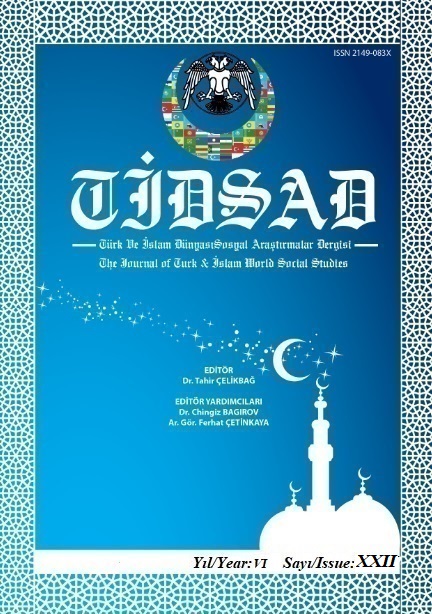Author :
Abstract
Bu çalışmanın amacı çocuk gelişim programı öğrencilerinin sanat eğitimine yönelik tutumlarının belirlenmesidir. Araştırmanın evrenini 2018-2019 eğitim-öğretim yılında Fırat Üniversitesi, Kayseri Üniversitesi ve Cumhuriyet Üniversitesi Çocuk Gelişim programı birinci ve ikinci sınıf öğrencileri oluşturmaktadır. Evrenin tümü örneklem olarak alınmıştır. Bu nedenle ayrıca örneklem seçimine gidilmemiştir. Araştırmada veri toplama aracı olarak Aykanat (2018) tarafından geliştirilen Sanat Eğitimine Yönelik Tutum Ölçeği kullanılmıştır. 5’li Likert tipide olan ve 23 maddeden oluşan ölçek sanattan hoşlanma ve sanatın katkısı (10), sanata yönelik olumsuz tutumlar (7), iletişim arttırıcı rolü (3) ve önemlilik rolü (3) olmak üzere dört alt faktörden oluşmaktadır. Öğrencilerin sanata yönelik tutumları hem genel hem de dört alt boyutta analiz edilmiş ve cinsiyet, sınıf düzeyi ve üniversite değişkenleri açısından farklılık olup olmadığı ortaya konmuştur.
Keywords
Abstract
The aim of this study is to determine the attitudes of the students of Child Development Program aboutart education. The population of the study consisted of first and second year students of Fırat University, Kayseri University and Cumhuriyet University Child Development Program in 2018-2019 academic year. The whole population was chosen as a sample. Therefore, no sample selection was made. Attitude Scale for Art Education developed by Aykanat (2018) was used as the data collection tool. The five-point scale which consists of 23 items includes four subscales entitled “enjoying art and contribution of art” (10 items),negative attitudes towards art” (7 items), “communication-enhancing role of art” (3 items) and “role of being important” (3 items). Students’ attitudes were analyze based on four subscales and whole scale and it was determined whether there were statistically significant differences in terms of gender, class level and university variables.
Keywords
- Abacı, O. (2015). Okul Sanatsal Gelişim, İlkay Ulutaş (Editör). Okul Öncesinde Görsel Sanat Eğitimi. Ankara, Hedef CS Yayıcılık.
- Ayaydın, A. ve Kurtuldu, M.K. (2010). Sanat Eğitimine Yönelik Tutum Ölçeğinin Geliştirilmesi. Fırat Üniversitesi Sosyal Bilimler Dergisi, 20(2), 201-209.
- Çellek, T. (2003). Sanat ve Bilim Eğitiminde Yaratıcılık.Pivolka, 2(8), 3-11.
- Dede, H. (2016). Öğrencilerin Sanata Karşı Bakış Açılarını Ortaya Koymaya Yönelik Bir Tutum Ölçeği. İdilSanat ve Dil Dergisi, 5 (25), 1559-1576.
- Dikici, A. (2006). Sanat Eğitimi ve Öğrencilerin Yaratıcılık Düzeyleri. Eğitim ve Bilim, 31(139), 3-9.
- Dinçer, Ç., Demiriz, S. ve Şimşek,I.( 2003). Okulöncesi Dönem Çocuğu Olan Ebeveynlerin Sanat Etkinliklerine Yaklaşımlarının İncelenmesi. Eğitim ve Bilim, 28(129), 50-63.
- Durualp, E. (2014). Sanat ve Gelişen Çocuk, Neriman Aral ve Gökhan Duman (Çeviri Editörleri). Çocuklarda Sanat ve Yaratıcılığın Gelişimi, 7. Basımdan Çeviri. Ankara, Nobel Yayıncılık.
- Feeney, S. & Moravcik, E. (1987). A Thing of Beauty: Aesthetic Development in Young Children. Young Children, 7-15.
- Ercan, Z.G., Günşen, G. ve Fazlıoğlu,Y. (2015). Okul Öncesinde sanatın Eğitimin Diğer alanlarıyla Bütünleştirilmesi, İlkay Ulutaş (Editör). Okul Öncesinde Görsel Sanat
- Kaymak, M.N. ve İlden, S. (2016). Okul Öncesi Öğretmenlerinin Okul Öncesinde Sanat Eğitimi Anlayışına İlişkin Görüşlerinin İncelenmesi. Akdeniz Sanat Dergisi, 9(18), 21-29.
- Mercin, L. ve Alakuş, A.O. (2007). Birey Ve Toplum İçin Sanat Eğitiminin Gerekliliği. D.Ü.Ziya Gökalp Eğitim Fakültesi Dergisi 9, 14-20.
- Ocak-Karabay, Ş. ve Bilir-Seyhan, G.(2017). Okul Öncesi Öğretmen Adayları İçin Görsel Sanat Eğitimi Ve Estetik. Sed, 5 (2), 213 -236.
- Özkan, B. Ve Girgin, F. (2014). Okul Öncesi Öğretmenlerinin Görsel Sanat Etkinliği Uygulamalarını Değerlendirmesi. Electronic Journal Of Vocational Colleges, 79-85.
- Ulutaş, İ. Ve Demiriz, S. (2015). Okul Öncesinde Görsel Sanat Eğitiminin Önemi ve Görsel Sanat Eğitimi Programı Özellikleri, İlkay Ulutaş (Editör). Okul Öncesinde Görsel Sanat





